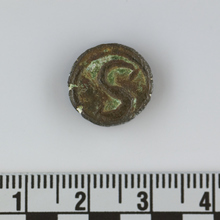Coin
MOA: University of British Columbia
3095/1677
Byzantine coin of Justin II, 565-578. Obverse: bust of Justin II, facing right; he wears a crown; to left, inscription says ‘DNIVS’; to right, ‘NIA’. Obverse: large ‘S’.
-
Iconographic Meaning
The face of the emperor on coins was a symbol of his authority. The portrait of Justin II is not characterized to him, instead reflecting general reference for the station and title of emperor.
-
History Of Use
“6 nummi” (denomination); DO# 189; Sear# 390. "DNIVS NIA” extends into “Dominus Noster Justin,” which translates to “Our Lord Justin”. This type of coin, the follis, is a large bronze coin that was introduced by the Emperor Anastasius in 498, marking a large departure from the Roman system of coinage inherited by the Byzantine Empire. It was the model for bronze Byzantine coinage for 200 years, facilitating small-scale trade and commerce. Originally, the basic follis in Constantinople was a heavy coin worth 40 nummia, with smaller follis parts equaling 20, 10, or 5 nummia. When the coin was debased and made lighter the value of it would decrease. Each provincial mints had their own divisions. In Alexandria the mint continuously produced follis parts worth 12, 6, and 3 nummia, until the province was lost to the Arab conquests. The 6 nummia coin made up a minor part of the local currency, circulating only within Egypt.
- Type of Item coin
- Culture Byzantine
- Material bronze metal
- Measurements height 0.3 cm, diameter 1.3 cm (overall)
- Previous Owner David Herman
- Received from David Herman
- Made in Alexandria
- Creation Date between 565 and 578
- Ownership Date before February 2, 2015
- Acquisition Date on February 2, 2015
- Item Classes metalwork
- Condition fair
- Accession Number 3095/1677

